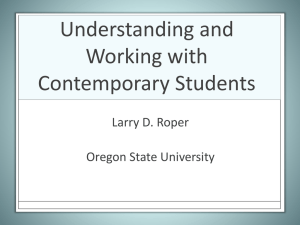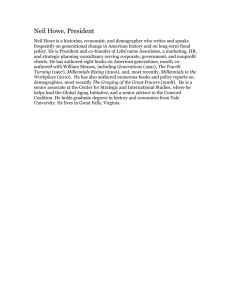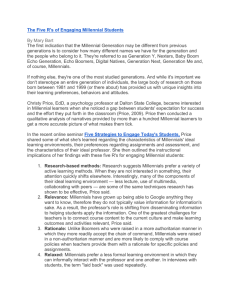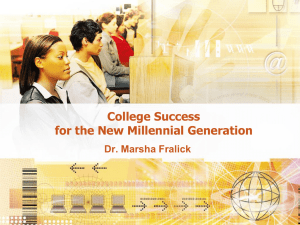Millennials in 2012
advertisement
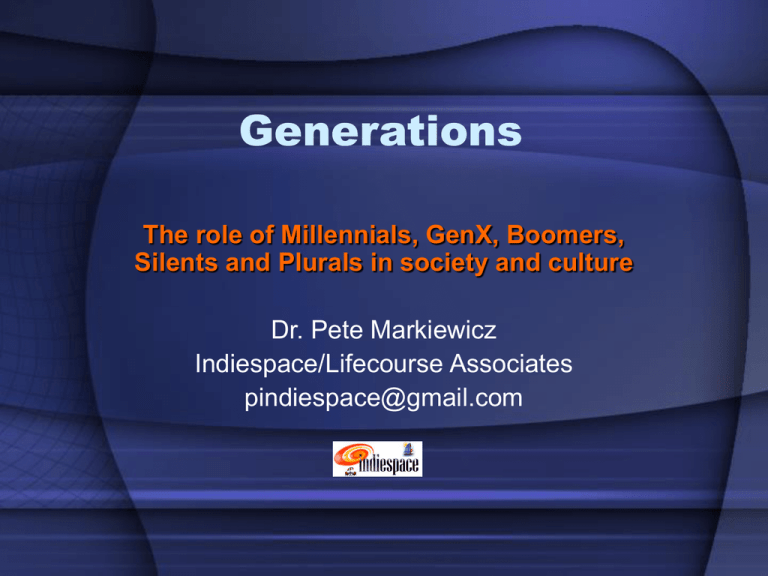
Generations The role of Millennials, GenX, Boomers, Silents and Plurals in society and culture Dr. Pete Markiewicz Indiespace/Lifecourse Associates pindiespace@gmail.com Topics • • • • What are generations? Cohort effects Defining generations Generational models – Generation Me – GenY – Millennials • The S&H generational model – Features – Evidence What are generations? • • • • Common birth range (cohorts) Shared place in history, common experience Features cross gender, racial, ethnic lines Retain attitudes independently of their biological age Generations DO NOT define individuals. Rather, they are a public “archetype” referenced by individuals within the generation. Life Stage vs. Generation • Example of “Life Stage” statements “…Kids always rebel” “…old people are conservative” • Example of “Generational” statements “…Boomers are re-defining what it means to be old” “...Youth today are closer to their parents in values and culture than the youth of 30 years ago” What is generationdependent? • Traits depending on cohort/generation – Taste in music, pop culture – Attitudes toward money, debt – Sense of personal/collective destiny • Traits depending on generation and life stage – Politics – Attitudes to children (the biggest effect is having them) • Traits depending on life stage – Candy preference – Risk-taking behavior • None of the above – Expectations for children of immigrants Cohort effects US CD sales by age, 1991-2005 40 Baby Boomers purchase more music than other generations, even as they grow older 35 30 Napster 10 to 14 15 to 19 25 Younger generations were buying less music before Napster 20 20 to 24 25 to 29 30 to 34 15 35 to 39 40+ 10 5 03 20 02 20 01 20 00 20 99 19 98 19 97 19 96 19 95 19 94 19 93 19 92 19 19 91 0 SOURCE: RIAA Cohort effects Suicide Rates, Teen and Adults 0.21 Boomers in 1979 0.19 Boomers in 2003 0.17 0.15 2003 0.13 1979 0.11 0.09 0.07 0.05 24 15 34 25 44 35 54 45 64 55 74 65 84 75 + 5 8 SOURCE: US 2000 Census data Cohort effects College Freshmen Survey, 1967-98: Personal Objectives Considered Important... Percent of All College Freshmen 90% 80% 70% 60% 50% 40% 30% 1967 1970 1973 1976 be very well off financially 1979 1982 1985 1988 1991 1994 1997 develop meaningful philosophy of life Source: UCLA Freshman Poll, "The American Freshman" (1997, 1999) http://www.gseis.ucla.edu/heri/norms06.php Out of wedlock – age effects 90.05 Out of Wedlock Births, by Age, 1980-2008 80.05 70.05 60.05 Ages 15-17 Ages 18–19 50.05 Ages 20–24 40.05 30.05 20.05 Ages 25–29 Ages 30–34 10.05 0.05 80 983 986 989 992 995 998 001 004 007 9 1 1 1 1 1 1 1 2 2 2 SOURCE: Childstats.gov Out of wedlock – relative 3.05 Out of Wedlock Births, Normalized, 1980-2008 2.55 Ages 15-17 2.05 Ages 18–19 1.55 Ages 20–24 1.05 Ages 25–29 0.55 Ages 30–34 0.05 80 983 986 989 992 995 998 001 004 007 9 1 1 1 1 1 1 1 2 2 2 SOURCE: Childstats.gov Defining generations • • • • • Birthrates and Population (parent optimism) Society-wide attitudes to children Parental child-rearing strategies Youth “zeitgeist” External behavior (crimes, community service participation, chosen professions, pop culture) • Internal states (beliefs, feelings, attitudes about oneself) • Perceived role in history (the generational “myth”) US births - per 1000 35.05 Birthrates per 1000 30.05 25.05 20.05 15.05 Relative Birthrates per Thousand, 1910-2009 WWII Gen Wave Boomer Wave Echo Boom 10.05 5.05 0.05 10 935 533 958 963 968 973 978 984 989 994 999 004 9 1 1 19 1 1 1 1 1 1 1 1 1 2 SOURCE: Childstats.gov US births - absolute Absolute Births, 1910-2009 4,500,000 4,000,000 Boomer Millions Millennial 3,500,000 3,000,000 Xer 2,500,000 Silent 2,000,000 0 35 53 58 63 68 73 78 84 89 94 99 04 1 19 19 19 19 19 19 19 19 19 19 19 19 20 US population by age U.S. Youth Population, Aged 15-24 in Millions, 1930 to 2020 45 Yearly Births, Millions 40 Millennial Wave 35 Boomer Wave 30 25 WWII Gen Wave 20 1930 1940 1950 1960 1970 1980 Year 1990 2000 2010 2020 Future years taken from official middle series projections. Source: U.S. Bureau of the Census (2000) Desire for kids Teen Pregnancy/Abortion Ratios, 1972-2008 6.05 Rowe vs. Wade 5.05 Fewer Pregnancies Carried to term 4.05 Ages 15-19 3.05 2.05 Millennial Birth Years More Pregnancies Carried to term 1.05 0.05 72 9 1 76 9 1 80 9 1 84 9 1 88 9 1 92 9 1 96 9 1 00 0 2 04 0 2 08 0 2 SOURCE: Guttmacher Institute Child-rearing strategies • 1970s – Child-rearing manuals advised letting the child “raise themselves” to avoid hampering parental self-discovery – Children were seen as “little adults” – Education strategies threw away rules in favor of exploration • 1990s – Child-rearing manuals advised strict rules with a paternal style – Family values replaced self-discovery – Children were seen as…well, children – Education moved to standards-based tests with scores and levels Society’s attitude to youth GenX (late 1980s) Millennial (early 2000s) Perceived role in history • Generations may see themselves as: – Heroes fixing the world – Prophets redeeming the world – Nomads trying to survive the world • Popular culture (e.g. movies) archetypes may describe generational styles Generational models • • • • • Generation Me (Twenge) GenY (Bruce Tulgan) Millennials Rising (Strauss & Howe) GenY (Ad Age) GenTech/Net (Various) How Generational Models Differ • Generation Me (Jean Twenge) – Focus on reported “inward” feelings – Negative about youth • GenY (Bruce Tulgan) – Focus on “outward” characteristics – Generations mapped to business savvy – Neutral about youth • Millennials Rising (Strauss & Howe, Winograd & Hais) – Focus on “outward” characteristics – Generations fit to archetypes – Very positive about youth • GenY (Ad Age) and GenTech/Net – Focus on current media use – Generations mapped to technology – Positive about youth (as avid consumers) Generation “Me” • Developed by Jean Twenge, PhD • Similar analysis in “Lost in Transition” by Smith et. al. • Emphasis: •Uses reported inner feelings to define generations •Connects negative youth attitudes to “broken” popular culture •Blames rise in narcissistic behavior due to indulgent Boomer parenting styles •Traces breakdown in moral reasoning to “postmodernism” education •Fragile economy driving increased http://www.mercatornet.com/articles/view/lost_in_transition_i dependency SOURCES: of children on parents Gen ME website: http://www.generationme.org/ Lost In Transition, Christian Smith et. al., Oxford Generation “Me” • Features – Overly-entitled attitudes with “special” feeling – Relativistic reasoning – “Submersion of self into private networks of technologically managed intimates and associates.” – Failure to launch from parents – Maximize options/postpone commitments – “Good” behavior due only to society pressure – Alienated, anxiety-burdened, miserable inner lives • Prescriptive – Parents should reduce “I am special” parenting – Schools should emphasize, critical thinking GenY (Bruce Tulgan) • Developed by Bruce Tulgan • Several authors make similar analysis (e.g. Carolyn Martin, Homo mobilis in The Economist) • Emphasis: •GenX * GenX = GenY •Pampered, nurtured, programmed by indulgent parents •Polished by social networks •More information-savvy than their bosses •Raised to equate social interaction with network communication •Born to multitask GenY (Bruce Tulgan) • Features: – – – – – – – Expect constant praise for “specialness” Information-smart: more factoids at their fingertips Local transactions are the only reality Constantly optimize work & life via social networks Demand work-life balance High value on personal self fulfillment Ignore business hierarchy • Prescriptive – – – – More equal employer-employee relationships Let them exploit their networks Flexibility in work time, methods Clearly describe, “gamelike” levels in a career Strauss & Howe • Developed by Bill Strauss & Neil Howe • Similar analysis by Morley Winograd & Mike Hais focuses on US political cycles • Emphasis: •Uses outer behavior to define generations •Generations are defined by parenting, zeitgeist •Describes an ~80 year cycle which sees the passage of 4 generational archetypes: •Civic – Millennial, “Greatest” Gen •Defines historical “realignments” •Adaptative – Silent, Plural based on features of rising •Prophet – Boomer, “Missionary” generation •Nomad – GenX, “Lost” SOURCES: Generations: A History of America’s Future Lifecourse Website: http://www.lifecourse.com Strauss & Howe • Features – – – – – Millennials are a “Civic” generation They will shift society in a “conventional” direction A “fix-it” gen repairing damage from the1960s and 1970s “Special” and “sheltered” but also “achieving” and “pressured” Millennials look to the group, rather than the individual to solve problems – Millennials represent the rising wave of a 40-year liberal political realignment – Someday, their “Prophet” children will rebel against them • Prescriptive – – – – Be Obi-wan to their Luke Skywalker Treat them as rule-followers Paternalistic management style Let them work in teams US generations - birth era Total US births in millions, 1950-1998 4.5 Postwar Boom Stagflation The Long Boom Millions of Births “Echo Boomers” 4.0 Various GenY Gen ME: 1970-2000 3.5 Births with unchanged fertility behavior since 1975 BOOMERS GEN-XERS MILLENNIALS 3.0 1950 1955 1960 1965 1970 1975 1980 1985 1990 1995 Unchanged fertility means unchanged at every age from 1975 levels. Source: U.S. Bureau of the Census (2000) SOURCE: Lifecourse Associates, from US 2000 Census data Generational ages in 2012 Silents 70-87 Millennials 10?-30 Boomers 52-69 Plurals 0-9? Xers 31-51 Millennials are where Boomers were in 1972, and Generation X was in 1986 “Boomers” (1943-1960) • Childhood – – – – Economic boom Children indulged Social stability Standards were loosening • Core values – – – – – – – Ideological Spiritual Judgmental, pessimistic Perfectionist Narcissistic Rebellious PROPHET “GenX” (1961-1981) • Childhood – – – – – Economic bust Children unprotected, criticized “Latch-key” childhood Social instability Standards were loosening • Core values – – – – – – – Pragmatism Authenticity “No Rules” edgy “Whatever works”, speed Transaction-focused Results-focused NOMAD GenX/Y childhood in media 1964 Children of the Damned 1979 The Brood 1967 Rosemary’s Baby 1980 The Children 1973 The Exorcist 1981 The Final Conflict 1974 It’s Alive! 1981 Halloween II 1976 Look What’s Happened to Rosemary’s Baby 1984 Firestarter 1976 The Omen 1976 Carrie 1977 Exorcist II: The Heretic 1977 Eraserhead 1978 It Lives Again 1978 Damien—Omen II 1978 Halloween 1984 Children of the Corn 1988 Child’s Play There’s only one thing wrong with the Davis baby . . . Millennials (1982-2004) • Childhood – – – – – – Economic boom Children protected & celebrated “Helicopter parents” make kids friends Ultra-planned childhood Social stability via “Lockdown” Standards were tightening • Core values – – – – – – – Special Confident, optimistic Rules-focused Connected Team-players Socially conscious CIVIC Millennial parental generation Boomer Birth years Xer Birth years Millennial Birth years SOURCE: US Census data, rebundled by generation http://www.census.gov Millennial diversity Nonwhite Race and Hispanic Ethnicity, by Generation, in 1999 40% 35.5% Percent of Generation 32.1% 30% 24.1% 19.3% 20% Other 14.0% Asian Black 10% Hispanic 0% Millennial born 1982 on Gen-X born 1961-81 Boom born 1943-60 Silent born 1925-42 G.I. born 1901-24 Source: U.S. Burea u of the Census (2000) How parents created Millennials • Boomer parents in the 1980s and 1990s ceased selfdiscovery – and focused on their children as “very special.” • Hands-off child rearing was replaced by child protection laws, “standards-based” school testing, and “no tolerance” behavior guidelines. • Even “progressive” Boomer parents developed hyper protective parenting styles (Elaine Bell Kaplan, USC sociology dept.) • Millennials are most often the children of immigrants, (firstgeneration high expectations) Helicopter parents “…Jessica Wolf is being watched. Every homework assignment she turns in, every class she attends, every test the 15-year-old sophomore takes at Sabino High School, her mother, Tina, can simply log on to her home computer and check her daughter's academic progress….via the Tucson Unified School District's parental-access system, an online network that allows parents to track attendance and grades and e-mail teachers. At some other local schools, parents can even check what their kids buy for lunch…” SOURCE: Daniel Scarpinato, Arizona Daily Star, http://www.azstarnet.com, 10.16.2005 Millennial childhood in media 1982 E.T The Extra-Terrestrial 1994 The Lion King 1986 Aliens 1994 Angels in the Outfield 1987 Three Men and a Baby 1997 Liar Liar 1987 Raising Arizona 1998 Rugrats: The Movie 1987 Baby Boom 1999 Big Daddy 1989 The Little Mermaid 1999 The Iron Giant 1989 Look Who’s Talking 2000 My Dog Skip 1989 Parenthood 2001 The Princess Diaries 1990 Look Who’s Talking Too 2002 Spy Kids 1990 Home Alone 2001 Monsters, Inc. 1991 Little Man Tate 2001 Harry Potter 1993 Three Men and a Little Lady 2002 Big Fat Liar 1993 Searching for Bobby Fisher 2002 About a Boy They changed her diapers. She changed their lives . . . Millennial traits summarized • According to S & H, Millennials are… – SPECIAL (wizards in training) – SHELTERED (naïve about real world) – CONFIDENT (I can do anything)) – CONVENTIONAL (rules, authority have value) – TEAM-PLAYER (group most important) – PRESSURED (work, work, work…) – ACHIEVING (value society’s rewards) Millennial reproduction 120.05 Teen Pregnancy, Birth and Abortion, Ages 15-19 100.05 80.05 60.05 Millennials Pregnancy Teen birthrate lowest in 70 years 40.05 Births Abortions 20.05 Abortion rate Comparable to 1972 0.05 72 976 980 984 988 992 996 000 004 008 9 1 1 1 1 1 1 1 2 2 2 SOURCE: Guttmacher Institute Millennial crime Serious Violent Crime, Age 12-17* Serious violent crimes are murders, rapes robberies, and aggravated results Offender Rate Victimization Rate Arrests 50 Millennials 40 GTA 1 30 GTA 3 20 10 08 20 06 20 04 20 02 20 00 20 98 19 96 19 94 19 92 19 90 19 88 19 86 19 84 19 82 19 80 0 19 Rate per 1,000 youths, 12-17 60 SOURCE: US. Department of Justice ·Bureau of Justice Statistics, US DOJ Office of Juvenile Justice and Delinquency Prevention School Shootings Grade/High School Shootings, 1992-2004 50 45 40 35 Millennials 30 25 20 15 10 5 0 1992 1994 1996 1998 2000 2002 2004 2006 2008 2010 SOURCE: National School Safety Center Report, http://www.schoolsafety.us/media-resources/school-associated-violent-deaths School violence Total faculty, student, staff violent deaths With student homicide and suicides ages 5-18 at school 70 60 Student 50 40 Millennials Faculty 30 20 10 Staff 0 1992 1994 1996 1998 2000 2002 2004 2006 2008 2010 SOURCE: National Center for Educational Statistics http://nces.ed.gov/programs/crimeindicators/crimeindicators2011/figures/figure_01_1.asp Drug use by generations Share of Teens Aged 12-17 Having Specified Drug Within the Last Month, 1979 to 1999 60% Percent of All Kids, 12-1 7 50% Boomers Xers Alcohol 40% Cigarettes 30% Millennials Binge Alcohol 20% Marijuana 10% Cocaine 0% 1979 1981 1983 1985 1987 1989 1991 1993 1995 1997 1999 Source: U.S. Substance Abuse and Mental Health Services Administration (1999) Millennial role models Who did Millennial Tweens Trust in 2001? 90 80 70 60 50 40 30 20 10 0 Parents Teachers Police Music Celebs Athletes SOURCE: ZOOM and Applied Research & Consulting LLC 2001 survey of nearly 10,000 kids aged 9-13 for PBS Millennial test scores SAT Scores of College-Bound Seniors – 1967-2006 550 540 530 520 Math Only 510 500 490 Millennials Critical Reading 480 470 19 67 19 70 19 73 19 76 19 79 19 82 19 85 19 88 19 91 19 94 19 97 20 00 20 03 20 06 460 SOURCE: College Board 2006 Report http://professionals.collegeboard.com/data-reports-research/sat/archived Millennial volunteerism Youth volunteer activity, 1976-2004 Millennial religion & politics Religion and Politics (2002) 70 Percent Support 60 50 40 Teens Age 27-59 30 20 10 0 School Prayer Fed. Aid to Religion Restrict Abortion SOURCE: UC Berkeley Survey Research Center as part of the center's Public Agendas and Citizen Engagement Survey (PACES) project, 2002 Millennial house of worship Millennial voting Voter Turnout, Presidential Elections 1964-2008 80 Elder 70 18-24 25-44 Midlife 45-64 65-100 Youth 50 Boomers 40 Xers Millennials 30 20 10 08 20 04 20 00 20 96 19 92 19 88 19 84 19 80 19 76 19 72 19 68 19 64 0 19 Percent Turnout 60 SOURCE: US Census, Historical Election Data http://www.census.gov/hhes/www/socdemo/voting/publications/historical/index.html Voting by generation Presidential Election Turnout, Rebundled by Generation, 1964-2008 80 60 Lost GI Silent 50 40 Boom Generation X 30 Millennial 20 10 2008 2006 2004 2002 2000 1998 1996 1994 1992 1990 1988 1986 1984 1982 1980 1978 1976 1974 1972 1970 1968 1966 0 1964 Percent Turnout 70 SOURCE: US Census, Historical Election Data http://www.census.gov/hhes/www/socdemo/voting/publications/historical/index.html Negative trends - activity Weekly Hours of Children Aged 3-12, by Activity Percent Change, from 1981 to 1997 Outdoors Free Play -51% -24% TV -13% Eating -11% Percent Change 38% School Studying 58% Organized Sports 86% Household Work 138% Visiting / Traveling -100% 169% -50% 0% 50% 100% 150% 200% Source: Institute for Social Research, University of Michigan (1999) Negative trends - health • Large numbers of Millennials have documented disabilities • Take drugs to get “better” (Boomers took drugs to get worse) • Lack of physical activity = obesity • Millennials could be the first US generation with a lower life expectancy than its parents Negative trends - gender Survey of Students Aged 14-18 in 1998-99, Answers by Gender Girls, 81% I try to do their best in all classes Boys, 64% Girls, 60% I take the most challenging courses Boys, 45% Girls, 49% I give priority to homework Boys, 31% Girls, 32% I earn mostly A's Boys, 18% 0% 10% 20% 30% 40% 50% 60% 70% 80% 90% 100% Source: Horatio Alger Association (1999) Millennial Gender Gap in College College “gender gap” by age in 2005 Low-income (Less than $30,000) Middle-income ($30,000 to $69,999) Upper Income ($70,000 or more) 1995-96 1999-00 2003-04 1995-96 1999-00 2003-04 1995-96 1999-00 2003-04 White 46 42 42 50 46 43 52 48 49 Black 32 36 36 48 42 42 41 48 48 Hispanic 43 43 39 46 51 42 50 52 49 Asian 53 51 47 57 48 50 52 54 51 All 44 42 40 50 47 44 51 48 49 Data: U.S. Department of Education, National Center for Education Statistics, National Postsecondary Student Aid Studies, 1995-96, 1999-2000, 2003-04 Income ranges adjusted for inflation to 1995-96 dollars; Source: ACE Center for Policy Analysis SOURCE: http://www.usatoday.com/news/education/2005-10-19-male-college-cover_x.htm Negative trends - work SOURCE: Economic Policy Institute http://www.epi.org/economic_snapshots/entry/leaving_in_droves/ Millennial economics 2012 • A typical U.S. household headed by someone 65 or older has 46 times the net worth of one headed by someone under 35 • The median net worth of households headed by someone 65 or older is 42% more than in 1984 • The median net worth for younger-age households was $3,662, down by 68% from the 1980s • Households headed by someone under age 35 had their median net worth reduced by 27% in 2009 as a result of unsecured liabilities, mostly a combination of credit card debt and student loans. Sources: Pew Research Center US Census Bureau Negative trends - debt Millennial “Zeitgeist” • • • • • • • • • • • • Society becoming safer Social norms continue to tighten Heroes replace anti-heroes The end of identity politics The end of the “get rich or die trying” era Entitlement (a generation’s naïve behavior) Generation Debt (especially for school) Failure to launch as the economy crashes “Outsider” violence and threats Girl power and “the boy problem” Class replaces race, gender as the social issue Politics and groups are (once again) the solution Recommended Reading Not Everyone Geta A Trophy: How to Manage Generation Y by Bruce Tulgan (2009, Wiley) ISBN: 978-0-470-25626-8 Millennial Makeover: MySpace, YouTube & The Future of American Politics by Morley Winograd, (2008, Rutgers) ISBN: 0-8135-4301-0 Millennials Incorporated by Lisa Orrell (2008, WyattMacKenzie) ISBN: 978-1-932279-82-5 Millennials and the Pop Culture by Pete Markiewicz, (2005, Lifecourse) http://lifecourse.com/store/books.html Generations: A History of America’s Future 1594 to 2069 by William Strauss & Neil Howe (1992, Harper) ISBN: 0688119123 Millennials Rising: The Next Great Generation (2000, Vintage), ISBN: 037570719-0


